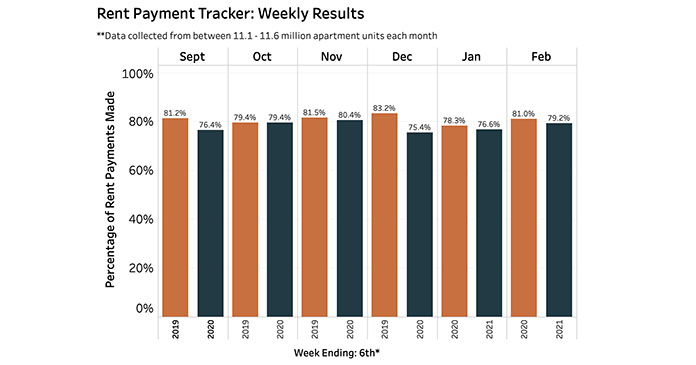The National Multifamily Housing Council (NMHC)’s Rent Payment Tracker found 79.2 percent of apartment households made a full or partial rent payment by February 6 in its survey of 11.6 million units of professionally managed apartment units across the country.
This is a 1.9 percentage point, or 216,479 household decrease from the share who paid rent through February 6, 2020 and compares to 76.6 percent that had paid by January 6, 2021. These data encompass a wide variety of market-rate rental properties across the United States, which can vary by size, type and average rental price.
“As we approach almost a full year of navigating the pandemic and the resulting financial distress, we remain encouraged by the COVID relief package passed at the end of 2020 that included critical support for apartment residents and the nation’s rental housing industry such as $25 billion in rental assistance, extended unemployment benefits and direct payments,” said Doug Bibby, NMHC President.
“However, as lawmakers consider further relief legislation, additional support for renters is clearly needed. Estimates of 2020 lost rent alone range from $27 billion to nearly $60 billion, despite the impact of previous federal COVID relief efforts. In the coming days and weeks, we urge members of Congress to pass legislation that directly meets renters’ basic financial hardships, protects the nation’s rental housing industry and efficiently provides funds to those who need it most.”
The NMHC Rent Payment Tracker metric provides insight into changes in resident rent payment behavior over the course of each month, and, as the dataset ages, between months. While the tracker is intended to serve as an indicator of resident financial challenges, it is also intended to track the recovery as well, including the effectiveness of government stimulus and subsidies.
However, noteworthy technical issues may make historical comparisons imprecise. For example, factors such as varying days of the week on which data are collected; individual companies’ differing payment collection policies; shelter-in-place orders’ effects on residents’ ability to deliver payments in person or by mail; the closure of leasing offices, which may delay operators’ payment processing; and other factors can affect how and when rent data is processed and recorded.
Find more information, including the methodology, on the NMHC Rent Payment Tracker.
The NMHC Rent Payment Tracker FAQ can be found here.













